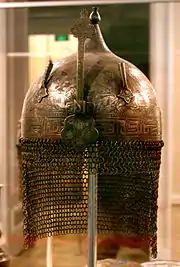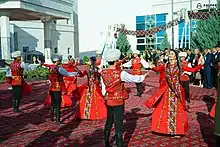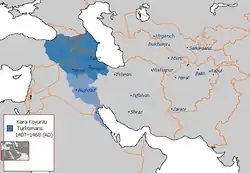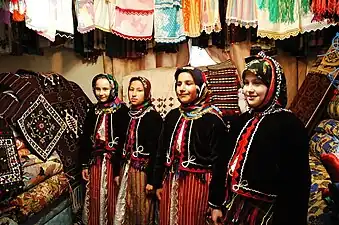Türkmenler | |
|---|---|
 Turkoman tower near Yerevan, Armenia | |
| Regions with significant populations | |
| Central Asia, South Caucasus, Middle East | |
| Languages | |
| Oghuz Turkic (Azerbaijani · Turkmen · Turkish) | |
| Religion | |
| Predominantly Islam (Sunni · Alevi · Bektashi · Twelver Shia) | |
| Related ethnic groups | |
| Other Turkic people |
Turkoman, also known as Turcoman[note 1] (English: /ˈtərkəmən/),[1] was a term for the people of Oghuz Turkic origin, widely used during the Middle Ages. Oghuz Turks were a western Turkic people that, in the 8th century A.D, formed a tribal confederation in an area between the Aral and Caspian seas in Central Asia, and spoke the Oghuz branch of the Turkic language family.
Turkmen, originally an exonym, dates from the High Middle Ages, along with the ancient and familiar name "Turk" (türk), and tribal names such as "Bayat", "Bayandur", "Afshar", and "Kayi". By the 10th century, Islamic sources were calling Oghuz Turks as Muslim Turkmens, as opposed to Shamanist or Buddhist Turks. It entered into the usage of the Western world through the Byzantines in the 12th century, since by that time Oghuz Turks were overwhelmingly Muslim. Later, the term "Oghuz" was gradually supplanted by "Turkmen" among Oghuz Turks themselves, thus turning an exonym into an endonym, a process which was completed by the beginning of the 13th century.
In Anatolia, since the Late Middle Ages, "Turkmen" was superseded by the term "Ottoman", which came from the name of the Ottoman Empire and its ruling dynasty. It remains as an endonym of semi-nomadic tribes of the Terekeme, a sub-ethnic group of the Azerbaijani people.
Today, a significant percentage of residents of Azerbaijan, Turkey, and Turkmenistan are descendants of Oghuz Turks (Turkmens), and the languages they speak belong to the Oghuz group of the Turkic language family. As of the early 21st century, this ethnonym is still used by the Turkmens of Central Asia,[2] the main population of Turkmenistan, who have sizeable groups in Iran, Afghanistan and Russia, as well as Iraqi and Syrian Turkmens, the other descendants of Oghuz Turks.
Etymology and history

The current majority view for the etymology of the ethnonym Türkmen or Turcoman is that it comes from Türk and the Turkic emphasizing suffix -men, meaning "'most Turkish of the Turks' or 'pure-blooded Turks.'"[3] A folk etymology, dating back to the Middle Ages and found in al-Biruni and Mahmud al-Kashgari, instead derives the suffix -men from the Persian suffix -mānind, with the resulting word meaning "like a Turk". While formerly the dominant etymology in modern scholarship, this mixed Turkic-Persian derivation is now viewed as incorrect.[4]
The first-known mention of the term "Turkmen", "Turkman" or "Turkoman" occurs near the end of the 10th century A.D in Islamic literature by the Arab geographer al-Muqaddasi in Ahsan Al-Taqasim Fi Ma'rifat Al-Aqalim. In his work, which was completed in 987 A.D, al-Muqaddasi writes about Turkmens twice while depicting the region as the frontier of the Muslim possessions in Central Asia.[5] According to medieval Islamic authors Al-Biruni and al-Marwazi, the term Turkmen referred to the Oghuz who converted to Islam.[6] There is evidence, however, that non-Oghuz Turks such as Karluks also have been called Turkomans and Turkmens.[7] Later during the Middle Ages, the term was extensively employed for Oghuz Turks, a western Turkic people, who established a large tribal confederation called Oghuz Yabgu in the 8th century A.D. This polity, whose inhabitants spoke Oghuz Turkic, occupied an area between the Aral and Caspian seas in Central Asia.[8][9]
The Seljuqs appeared in the beginning of the 11th century in Mawarannahr.[10] Muslim Oghuz people, generally identified as Turkmens by then,[11] rallied around the Qinik tribe that made up the core of the future Seljuq tribal union and the state they would create in the 11th century.[12]

Since the Seljuk era, the sultans of the dynasty created military settlements in parts of the Near and Middle East to strengthen their power; large Turkmen settlements were created in Syria, Iraq, and Eastern Anatolia. After the Battle of Manzikert, the Oghuz extensively settled throughout Anatolia and Azerbaijan. In the 11th century, Turkmens densely populated Arran.[13] The 12th-century Persian writer al-Marwazi wrote about the arrival of Turkmens to Muslim lands, portraying them as people of noble character who are strong and persistent in battle because of their nomadic lifestyle, and calling them sultans (rulers).[14]
"Turkoman" entered into the usage of the Western world through the Byzantines in the 12th century.[15] By the beginning of 13th century, it became an endonym among Oghuz Turks themselves.[16]
The Turkmens also included the Yiva and Bayandur tribes, from which the ruling clans of the states of Qara Qoyunlu and Aq Qoyunlu emerged. After the fall of Aq Qoyunlu, the Turkmen tribes—partly under their own name, for example Afshars, Hajilu, Pornak, Deger, and Mavsellu—united in a Turkmen Qizilbash tribal confederation.[17]
Culture

By the 10th century A.D, Turkmens were predominantly Muslim. They later found themselves divided into Sunni and Shia branches of Islam.[18] Medieval Turkmens markedly contributed to the expansion of Islam with their extensive conquests of previously Christian lands, specifically those of Byzantine Anatolia and the Caucasus.[19]
Language

Turkmens primarily spoke languages that belong or belonged to the Oghuz branch of Turkic languages, which included such languages and dialects as Seljuq, Old Anatolian Turkish, and old Ottoman Turkish.[20] Kashgari had cited phonetic, lexical and grammatical features of the language of Oghuz-Turkmens;[21] he also identified several dialects and presented a couple of examples displaying the differences.[22]
Old Anatolian language, introduced to Anatolia by Seljuk Turkmens[23][24] who migrated westward from Central Asia to Khorasan and further to Anatolia during the Seljuk expansion in the 11th century, was widely spoken by Turkmens of the area until the 15th century.[25] It is also one of the known ancient languages within the Oghuz group of Turkic languages, along with old Ottoman.[26] It displays certain characteristics peculiar to eastern Oghuz languages such as modern Turkmen and Khorasani Turkic languages,[27][28] rather than western Oghuz languages such as Turkish or Azerbaijani. Such Old Anatolian Turkic features as bol- "to be(come)", also present in modern Turkmen[29] and Khorasani Turkic,[30] is ol in modern Turkish.[31]
Literature

Book of Dede Korkut is considered an Oghuz masterpiece.[32][33] Other prominent works of literature produced during the High Middle Ages also include the Oghuzname, Battalname, Danishmendname, Köroğlu epics, which are part of the literary history of Azerbaijanis, Turks of Turkey, and Turkmens.[34]
The Book of Dede Korkut is a collection of epics and stories bearing witness to the language, the way of life, religions, traditions and social norms of the Oghuz Turks.[35]
Modern use

In Anatolia in the late Middle Ages, the term "Turkmen" was gradually supplanted by the term "Ottomans".[36] The Ottoman ruling class identified themselves as Ottomans until the 19th century.[37] In the late 19th century, as the Ottomans adopted European ideas of nationalism, they preferred to return to a more common term Turk instead of Turkmen, whereas previously Turk was used to exclusively refer to Anatolian peasants.[38]
The term continued to be used interchangeably with other ethnohistorical terms for the Turkic people of the area, including Turk, Tatar and Ajam, well into the early 20th century.[39][40][41] In the early 21st century, "Turkmen" remains as the self-name for the semi-nomadic tribes of the Terekime, a sub-ethnic group of the Azerbaijani people.[42]
In the early 21st century, the ethnonyms "Turkoman" and "Turkmen" are still used by the Turkmens of Turkmenistan,[43] who have sizeable groups in Iran,[44][45] Afghanistan,[46] Russia,[47] Uzbekistan,[48] Tajikistan[49] and Pakistan,[50] as well as Iraqi and Syrian Turkmens, descendants of the Oghuz Turks who mostly adhere to an Anatolian Turkish heritage and identity.[51] Most Iraqi and Syrian Turkmens are descendants of Ottoman soldiers, traders, and civil servants who were taken into Iraq from Anatolia during the rule of the Ottoman Empire.[52] Turks of Israel[53] and Lebanon,[54] Turkish sub-ethnic groups of Yoruks[55][56] and Karapapaks (sub-ethnic group of Azerbaijanis)[57] are also referred to as Turkmens.[58][59]
"Turkoman", "Turkmen", "Turkman" and "Torkaman" were – and continue to be – used interchangeably.[60][61][62]
List of states and dynasties of Turkoman origin
| Name | Years | Map | Notes |
|---|---|---|---|
| Ahmadilis | 1122–1225 | – |
– |
| Salghurids | 1148–1282 | – |
|
| Zengids | 1127–1250 |  |
– |
| Ottoman Empire | c. 1299–1922 |  |
Founded by Turkoman tribal leader Osman I. |
| Qara Qoyunlu | 1374–1468 |  |
|
| Aq Qoyunlu | 1378–1503[note 2] |  |
|
| Qutb Shahi dynasty | 1518–1687 |  |
|
| Afsharid Iran | 1736–1796 |  |
|
Turkomans also founded many small states in Anatolia and neighboring regions, originally one of them, the Ottomans, turned into an empire. See Anatolian beyliks. | |||
Notes
- ↑ also called Turkman;
- Middle Turkic: تُركْمانْ
- Ottoman Turkish: sing. تركمن (Türkmen) or تركمان (Türkmân), pl. تراكمه (Terâkime)
- Azerbaijani: sing. Türkmən or Türkman, pl. Tərakimə
- Turkish: Türkmen
- Turkmen: Türkmen
- Latin: Turcomannus
- ↑ However some Aq Qoyunlu rump states continued to rule until 1508, before they were absorbed into the Safavid Empire by Ismail I.[65]
References
- ↑ "Turkoman: definition". Merriam-Webster Dictionary. Merriam Webster. n.d. Retrieved 20 December 2022.
- ↑ Qadirov, Sh; Abubakirova-Glazunova, N. "Turkmens". Big Russian Encyclopedia (in Russian).
- ↑ Clark, Larry (1996). Turkmen Reference Grammar. Harrassowitz. p. 4. ISBN 978-3-447-04019-8., Annanepesov, M. (1999). "The Turkmens". In Dani, Ahmad Hasan (ed.). History of civilizations of Central Asia. Motilal Banarsidass. p. 127. ISBN 978-92-3-103876-1., Golden, Peter (1992). An introduction to the history of the Turkic peoples: ethnogenesis and state-formation in the medieval and early modern Eurasia and the Middle East. Harrassowitz. pp. 213–214..
- ↑ Clark, Larry (1996). Turkmen Reference Grammar. Harrassowitz. pp. 4–5. ISBN 978-3-447-04019-8.,Annanepesov, M. (1999). "The Turkmens". In Dani, Ahmad Hasan (ed.). History of civilizations of Central Asia. Motilal Banarsidass. p. 127. ISBN 978-92-3-103876-1.,Golden, Peter (1992). An introduction to the history of the Turkic peoples: ethnogenesis and state-formation in the medieval and early modern Eurasia and the Middle East. Harrassowitz. pp. 213–214..
- ↑ Al-Marwazī, Sharaf Al-Zämān Tāhir Marvazī on China, the Turks and India, Arabic text (circa A.D. 1120) (English translation and commentary by V. Minorsky) (London: The Royal Asiatic Society, 1942), p. 94
- ↑ Abu al-Ghazi Bahadur, «Genealogy of the Turkmens» Commentary 132: Then the name "Turkmen" was assigned to one of the most powerful tribal associations - to the Oghuz people.
- ↑ Clark, Larry (1998). Turkmen Reference Grammar. Harrassowitz Verlag. p. 14. ISBN 3-447-04019-X.
One of those dialects appears to have been spoken by the Karluk Turkmen, who were identified by Kashgari as "A tribe of the Turks. They are nomads, not Oghuz, but they are also Turkmen."
- ↑ Karamustafa, A. (2020). "Who were the Türkmen of Ottoman and Safavid lands? An overlooked early modern identity". Der Islam. 97 (2): 477. doi:10.1515/islam-2020-0030. S2CID 222317436.
- ↑ Barthold, V.V (1966). Sochineniya (in Russian). Moscow: Nauka. p. 558.
Whatever the former significance of the Oghuz people in the Eastern Asia, after the events of the 8th and 9th centuries, it focuses more and more on the West, on the border of the Pre-Asian cultural world, which was destined to be invaded by the Oghuz people in the 11th century, or, as they were called only in the west, by the Turkmen.
- ↑ A ́goston, Ga ́bor; Masters, Bruce Alan (2010). Encyclopedia of the Ottoman Empire. Infobase Publishing. p. 515.
The Seljuks emerged in the beginning of the 11th century in Transoxania (present-day Uzbekistan). Until the early 14th century, they ruled over Khorasan, Khwarezm, Iran, Iraq, Hejaz, Syria, and Anatolia.
- ↑ "Gozz". Encyclopedia Iranica.
- ↑ Golden, Peter B. (1996) [1984]. "The Turkic peoples and Caucasia". In Suny, Ronald Grigor (ed.). Transcaucasia, Nationalism, and Social Change: Essays in the History of Armenia, Azerbaijan, and Georgia. Ann Arbor: University of Michigan Press. pp. 45–67. ISBN 0-472-09617-6.
- ↑ Golden 1996, pp. 45–67.
- ↑ Hillenbrand, Carole (2007). Turkish Myth and Muslim Symbol. Edinburgh University Press. p. 148. ISBN 978-0-7486-2572-7.
- ↑ Zachariadou, Elizabeth (1991). Alexander Kazhdan (ed.). "Turkomans". Oxford University Press. pp. 10–32.
- ↑ Lewis, Geoffrey (1974). The Book of Dede Korkut. Penguin Books. p. 10.
- ↑ Encyclopaedia Iranika «AQ QOYUNLŪ»: "The surviving Āq Qoyunlū tribes and groups were absorbed, in some cases years later, into the Qizilbāš tribes; in this process, the Afšār retained their tribal identity while others, such as the Ḥāǰǰīlū, Döḡer, Mawṣellū, and Pornāk, were merged into a new tribe called Turkman".
- ↑ Ward, Steven (2014). Immortal, A Military History of Iran and Its Armed Forces. Washington, DC: Georgetown University Press. p. 44. ISBN 978-1-62616-032-3.
Selim was a devout Sunni who hated the Shia as much as Ismail despised the Sunni. He saw the Shia Turkman of Anatolia as a potential "fifth column"...
- ↑ Zarcone, Thierry; Hobart, Angela, eds. (2013). Shamanism and Islam. I.B.Tauris & Co Ltd. pp. 98–101. ISBN 978-1-84885-602-8.
- ↑ Robbeets, Martine (2020). The Oxford Guide to the Transeurasian Languages. Oxford University Press. pp. 393–394.
- ↑ Clark 1998, p. 13.
- ↑ Clark 1998, p. 14.
- ↑ Schiewer, Gesine Lenore (2022). Language and Emotion. Volume 1. Walter de Gruyter GmbH & Co KG. p. 284.
- ↑ Koprulu, Mehmed Fuad (2006). Early Mystics in Turkish Literature. Routledge. p. 207.
- ↑ Lars Johanson; Christiane Bulut; Otto Harrassowitz Verlag (2006). Turkic-Iranian Contact Areas: Historical and Linguistic Aspects. p. 5.
- ↑ Robbeets 2020, p. 393.
- ↑ Clark 1998, p. 15.
- ↑ Brown, Keith (2010). Concise Encyclopedia of Languages of the World. Elsevier. p. 1117. ISBN 978-0-080-87775-4.
- ↑ Clark 1998, p. 513.
- ↑ Ziyayeva, Zemine (2006). "Khorasan languages". Journal of Caucasian University. Baku. 18: 91–97.
- ↑ Backus, Ad (2014). Colloquial Turkish. Routledge. p. 266.
- ↑ Weber, Harry B. (1978). The Modern Encyclopedia of Russian and Soviet Literature, Vol.2. University of Michigan. pp. 13–15.
- ↑ "Intangible Heritage: Nine elements inscribed on Representative List". UNESCO. 28 November 2018. Retrieved 2018-11-29.
- ↑ Istoriya Vostoka (History of the East), Vol.2 (in Russian). Vostochnaya Literatura. 2002. ISBN 5-02-017711-3.
- ↑ The Book of Dede Korkut. Translated by Lewis, Geoffrey. London: Penguin. 1974. p. 7. ISBN 0-14-044298-7.
- ↑ Eremeev, Dmitry (1971). Этногенез турок: происхождение и основные этапы этнической истории (in Russian). Наука, ГРВЛ. pp. 130–137.
- ↑ Kushner, David S.. "Self-Perception and Identity in Contemporary Turkey." Journal of Contemporary History 32 (1997): p. 219
- ↑ Kushner, David S.. "Self-Perception and Identity in Contemporary Turkey." Journal of Contemporary History 32 (1997): pp. 2020-221
- ↑ Kemp, Geoffrey; Stein, Janice Gross (1995). Powder Keg in the Middle East. Rowman & Littlefield. p. 214. ISBN 978-0-8476-8075-7.
- ↑ Тюрки. Brockhaus and Efron Encyclopedic Dictionary (in Russian). 1890–1907. Archived from the original on 13 January 2012. Retrieved 29 January 2012.
- ↑ Tsutsiev, Arthur. "18. 1886–1890: An Ethnolinguistic Map of the Caucasus". Atlas of the Ethno-Political History of the Caucasus, New Haven: Yale University Press, 2014, pp. 48-50. "Tatars" (or in rarer cases, "Azerbaijani Tatars") to denote Turkic-speaking Transcaucasian populations that would later be called "Azerbaijanis"
- ↑ Hajiyeva, Sakinat (1990). Terekemes of Daghestan (in Russian). Nauka (Science). pp. 3–7. ISBN 5-02-016761-4.
- ↑ https://bigenc.ru/ethnology/text/4211260 "Big Russian Encyclopedia"
- ↑ "Ethnologue". Retrieved 8 August 2018.
- ↑ CIA World Factbook Iran
- ↑ "US Library of Congress Country Studies-Afghanistan: Turkmen".
- ↑ 2002 Russian census
- ↑ Alisher Ilhamov (2002). Ethnic Atlas of Uzbekistan. Open Society Institute: Tashkent.
- ↑ 2002 Tajikistani census (2010)
- ↑ "Afghans in Quetta: Settlements, Livelihoods, Support Net works and Cross-Border Linkages". Archived from the original on 2012-10-16. Retrieved 2020-09-15.
- ↑ Triana, María (2017), Managing Diversity in Organizations: A Global Perspective, Taylor & Francis, p. 168, ISBN 978-1-317-42368-3,
Turkmen, Iraqi citizens of Turkish origin, are the third largest ethnic group in Iraq after Arabs and Kurds and they are said to number about 3 million of Iraq's 34.7 million citizens according to the Iraqi Ministry of Planning.
- ↑ International Crisis Group (2008), Turkey and the Iraqi Kurds: Conflict or Cooperation?, Middle East Report N°81, 13 November 2008: International Crisis Group, archived from the original on 12 January 2011, "Turkomans are descendents of Ottoman Empire-era soldiers, traders and civil servants... The 1957 census, Iraq's last reliable count before the overthrow of the monarchy in 1958, put the country's population at 6,300,000 and the Turkoman population at 567,000, about 9 per cent...Subsequent censuses, in 1967, 1977, 1987 and 1997, are all considered highly problematic, due to suspicions of regime manipulation".
- ↑ Suwaed, Muhammad (2015), "Turkmen, Israeli", Historical Dictionary of the Bedouins, Rowman & Littlefield, p. 237, ISBN 978-1-4422-5451-0
- ↑ Orhan, Oytun (2010), The Forgotten Turks: Turkmens of Lebanon (PDF), ORSAM, archived from the original (PDF) on 2016-03-03
- ↑ Solak, İbrahim. XVI. Yüzyılda Maraş ve Çevresinde Dulkadirli Türkmenleri.
- ↑ Yusuf Durul: Flat-woven rugs made by "Yürüks". Ak Yayınları, 1977, page 60.
- ↑ Article "Terekimes» Archived 2018-01-09 at the Wayback Machine: "The term 'Terekem' is usually associated with the ethnonym 'Turkmen' ".
- ↑ İbrahim Aksu, "An Onomastic Study of Turkish Family Names, Their Origins, and Related Matters." 2005 , page 50.
- ↑ Insight Guides Turkey - Apa Publications (UK) Limited, 2015.
- ↑ Barkey, Henri (2005). Turkey and Iraq: The Perils (and Prospects) of Proximity. Purdue University. p. 7.
- ↑ Merriam-Webster's Collegiate Encyclopedia. Merriam-Webster, Inc. 2000. p. 1655. ISBN 0-87779-017-5.
- ↑ Skutsch, Carl (2013). Encyclopedia of the World's Minorities. Routledge. p. 1223.
- 1 2 Roy, Kaushik (2014). Military Transition in Early Modern Asia, 1400-1750. Bloomsbury. "Post-Mongol Persia and Iraq were ruled by two tribal confederations: Akkoyunlu (White Sheep) (1378–1507) and Qaraoyunlu (Black Sheep). They were Persianate Turkoman Confederations of Anatolia (Asia Minor) and Azerbaijan."
- 1 2 Arjomand, Saïd Amir (2016). "Unity of the Persianate World under Turko-Mongolian Domination and Divergent Development of Imperial Autocracies in the Sixteenth Century". Journal of Persianate Studies. 9 (1): 11. doi:10.1163/18747167-12341292.
The disintegration of Timur's empire into a growing number of Timurid principalities ruled by his sons and grandsons allowed the remarkable rebound of the Ottomans and their westward conquest of Byzantium as well as the rise of rival Turko-Mongolian nomadic empires of the Aq Qoyunlu and Qara Qoyunlu in western Iran, Iraq, and eastern Anatolia. In all of these nomadic empires, however, Persian remained the official court language and the Persianate ideal of kingship prevailed.
- ↑ Charles Melville (2021). Safavid Persia in the Age of Empires: The Idea of Iran. Vol. 10. p. 33.
Only after five more years did Esma'il and the Qezelbash finally defeat the rump Aq Qoyunlu regimes. In Diyarbakr, the Mowsillu overthrew Zeynal b. Ahmad and then later gave their allegiance to the Safavids when the Safavids invaded in 913/1507. The following year the Safavids conquered Iraq and drove out Soltan-Morad, who fled to Anatolia and was never again able to assert his claim to Aq Qoyunlu rule. It was therefore only in 1508 that the last regions of Aq Qoyunlu power finally fell to Esma'il.
- ↑ "AQ QOYUNLŪ" at Encyclopædia Iranica; "Christian sedentary inhabitants were not totally excluded from the economic, political, and social activities of the Āq Qoyunlū state and that Qara ʿOṯmān had at his command at least a rudimentary bureaucratic apparatus of the Iranian-Islamic type. [...] With the conquest of Iran, not only did the Āq Qoyunlū center of power shift eastward, but Iranian influences were soon brought to bear on their method of government and their culture."
- ↑ Christoph Marcinkowski, Shi'ite Identities: Community and Culture in Changing Social Contexts, 169-170; "The Qutb-Shahi kingdom could be considered 'highly Persianate' with a large number of Persian-speaking merchants, scholars, and artisans present at the royal capital."
Further reading
- Kellner-Heinkele, Barbara (2000). "Türkmen". In Bearman, P. J.; Bianquis, Th.; Bosworth, C. E.; van Donzel, E. & Heinrichs, W. P. (eds.). Encyclopaedia of Islam. Volume X: T–U (2nd ed.). Leiden: E. J. Brill. pp. 682–685. ISBN 978-90-04-11211-7.
- Faruk Sümer (1988–2016). "TÜRKMENLER XI. yüzyıldan itibaren Oğuzlar'a verilen ad.". TDV Encyclopedia of Islam (44+2 vols.) (in Turkish). Istanbul: Turkiye Diyanet Foundation, Centre for Islamic Studies.

.jpg.webp)